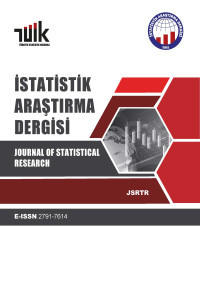Bir Broyler Tavuk Entegrasyonu için Kümes Performans Analizi ve Civciv Girişi Planlaması
Artan broyler tavuk üretimi Türkiye ekonomisi üzerinde önemli bir etkiye sahiptir. Türkiye'deki kişi başına düşen tavuk eti üretimi dünya sıralamasındaki ilk 20 ülkenin ortalama üretimine çok yakındır. Üretim birleşik organizasyonlar tarafından yapılmakta olup, entegrasyonunun başında üretimin her safhasıyla bağlantılı olan bir tavuk işletmecisi bulunmaktadır. Bir entegrasyonda birçok karmaşık süreç, evre ve grup bulunmakta olup, bunlar beraberlerinde çok sayıda ilginç problem getirmektedir. Bu çalışmada, Türkiye'nin Marmara Bölgesinde yer alan orta büyüklükteki bir tavuk işletmecisinin gereksinimlerinden yola çıkarak, piliç yetiştirme evresindeki taktik ve işletme planları ele alındı. Varyans analizini kullanarak, mevcut kümeslerin performansları karşılaştırıldı ve performans ölçütlerini etkileyen faktörleri belirlendi. Daha sonra, bu performans analizi çalışmasının sonuçlarını kullanan bir tamsayılı doğrusal programlama modeli ile planlama çevreninde tavuk işletmecisinin en ucuz maliyetle birlikte çalışabileceği kümes işletmeleri belirlendi ve bu kümeslere civciv girişlerinin planlaması yapıldı.
Anahtar Kelimeler:
Varyans analizi, Broyler tavuk üretimi, Tamsayılı doğrusal programlama, Performans analizi
Broiler House Performance Analysis and Chick Entrance Planning for a Broiler Chicken Integration
Increasing rates of chicken meat production has a substantial impact on the Turkish economy. Per capita production in Turkey is close to the average production of the top 20 countries in the world. The production is done by integrated organizations, incorporating an integrator chicken company affiliated with all aspects of the production in an organization. There are many complicated processes, stages and parties involved in a typical integration, bringing with them many interesting problems. In this paper, we focus on tactical and operational decisions required during the broiler growing stage, motivated by the requirements of a moderate-sized integrator in the Marmara Region of Turkey. We use analysis of variance to compare the performances of available broiler houses, and to find the factors effecting the performance measures. Then, we present a mixed-integer linear program which uses the results of our performance analysis to find the least costly set of broiler houses with which the integrator should work, and the chick entrance times into these houses over a planning period.
Keywords:
Analysis of variance, Broiler chicken production, Mixed-integer linear program, Performance analysis,
___
- Çiçek. H., Günlü, A., Tandoğan, M., 2009. A study on determination of factors affecting profits with quantitative models in commercial egg production. Ankara Üniversitesi Veterinerlik Fakültesi Dergisi, 56, 313-316.
- FAOSTAT, 2013. Retrieved from http://faostat3.fao.org/home/index.html#VISUALIZE_TOP_20.
- Fujikoshi, Y.. 1993. Two-way ANOVA models with unbalanced data. Discrete Mathematics. 116. 315-334.
- Haupt. A., Kane, T.T., Haub. C., 2011. PBR’s population handbook. Retrieved from http://www.prb.org/pdf11/prb-population-handbook -2011.pdf.
- Sarıözkan, S., Güçlü, B. K., İşcan, K. M., 2009. Yumurta tavuklarında yerleşim sıklığı, rasyon enerji düzeyi ve rasyona karnitin ilavesinin teknik ve ekomomik açıdan değerlendirilmesi. Ankara Üniversitesi Veterinerlik Fakültesi Dergisi, 56. 283-288.
- Satır, B., 2003. A general production and financial planning model for integrated poultry organizations. Technical report. Middle East Technical University. Ankara, Turkey.
- Searle, S. R., 1987. Linear models for unbalanced data. Wiley series in probability and mathematical statistics: Applied probability and statistics. Wiley.
- Shaw. R. G., Mitchell-Olds, T., 1993. Anova for unbalanced data: An overview. Ecology, 74(6), 1638-1645.
- Taube-Netto, M., 1996. Integrated planning for poultry production at Sadia. Interfaces, 26(1). 38-53.
- Tesseraud, S., Pym, R., Le Bihan-Duval, E., Duclos, M., 2003. Response of broilers selected on carcass quality to dietary protein supply: Live performance, Muscle development, and circulating insulin-like growth factors (IGF-I and-II). Poultry Science, 82(6), 1011-1016.
- Yates, F., 1934. The analysis of multiple classifications with unequal numbers in the different classes, Journal of the American Statistical Association, 29, 52-66.
- ISSN: 1303-6319
- Başlangıç: 2002
- Yayıncı: TÜİK
Sayıdaki Diğer Makaleler
Bazı Ekonomik Değişkenler Açısından Ülkelerin Gelişmişlik Sıralamalarındaki Değişiminin İncelenmesi
Taner TUNÇ, Yüksel ÖNER, Kamil ALAKUŞ, Seval AKSOY
Monte Carlo İntegrasyonunda Varyans Azaltıcı Yeni Bir Teknik
İlkay ALTINDAĞ, Nimet YAPICI PEHLİVAN
Uzunlamasına Verilerin Yer Aldığı Faktöriyel Tasarımlar için Parametrik Olmayan Yaklaşım
Can ATEŞ, Yasemin GENÇ, Meliha HAFIZ, Derya ÖZTUNA, Şehim KUTLAY, Bülent SEÇKİN
Aslı AŞIK YAVUZ, A. Sinan TÜRKYILMAZ
Bir Broyler Tavuk Entegrasyonu için Kümes Performans Analizi ve Civciv Girişi Planlaması
